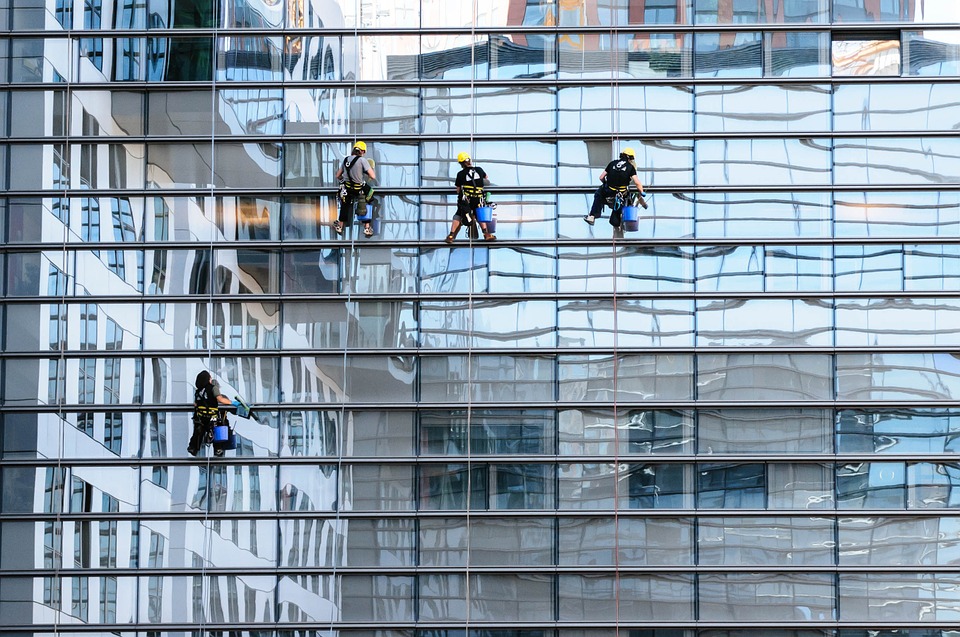Facade access equipment
Contents |
[edit] Introduction
The term ‘facade’ can refer to any predominantly vertical face of a building envelope, such as an external wall. In terms of the built environment, the term ‘access’ refers to the means or ability to approach and/or enter a place.
Facade access equipment is used to allow regular maintenance tasks such as cleaning and repairing surfaces, windows, glazing, cladding and other components of the facade as well as for lifting materials.
[edit] Systems
Facade access is provided by systems that allow crews to perform tasks that are required as part of their cleaning and maintenance responsibilities. Facade access equipment should provide safe access to all parts of the building facade, including hard-to-reach places.
In existing buildings, this equipment may be less than optimal if maintenance requirements were not considered during the construction process. For historic buildings, special facade access strategies and devices may be required, particularly in cases where restrictions may be imposed on projects with listed building or conservation area status.
In new construction projects where facade access will be an ongoing requirement of the building, the type of equipment should be considered at an early stage of the project.
[edit] Temporary or permanent facade access equipment
Temporary equipment can include scaffolding and aerial work platforms. Aerial work platforms may include elevating work platforms, cherry pickers, bucket trucks, mobile elevating work platforms (MEWPs) and so on. See also: Window cleaning.
Permanent facade access may be provided by equipment such as travelling ladders (which can be electronically powered or manually moved), transport systems (such as maintenance monorails), gantries or rope systems with fixed anchors (or abseiling systems).
[edit] Rope access equipment
Recommendations and guidance for the use of rope access systems for work at height conditions is available in BS 7985:2013, Code of practice for the use of rope access methods for industrial purposes. Recommendations and guidance supplementary to BS ISO 22846.
BS 7985:2013 is applicable to the use of rope access systems in buildings where ropes are suspended from - or connected to - the structure and are used as the primary means of access, egress or support and as the primary means of protection against a fall. The standard is applicable to those who use rope access methods and those who commission rope access work (such as building owners and contractors) as well as safety officers.
The information and guidance given in Clause 4, 5 and 12.1 of BS 7985:2013 is of particular relevance to building owners and contractors.
[edit] Suspended access equipment SAE
There are also permanent speciality facade access systems known as suspended access equipment (SAE). This includes cradles, mechanical building maintenance units (BMUs) and other types of platforms that are generally suspended by steel wire ropes from a securely mounted overhead structure (also known as a suspension rigs).
SAEs can normally be raised and lowered and moved laterally across the façade of a building. Recommendations and guidance for SAE systems is available in BS 6037-1:2017, Planning, design, installation and use of permanently installed access equipment. Code of practice - Suspended access equipment. The standard can be used by building owners, facility managers, safety officers, architects, structural and construction engineers, and specifiers to ensure the provision of safe equipment in construction, refurbishment and facilities management.
[edit] Related articles on Designing Buildings
- Building services.
- Don’t Look Down! – Skyscraper window cleaning through the ages.
- Façade.
- Facade cleaning.
- Facade maintenance.
- Roofing repairs.
- Safety in high places.
- Work at height.
- Work package bill of quantities.
[edit] External resources
- BSI, BS 6037-1:2017, Planning, design, installation and use of permanently installed access equipment. Code of practice - Suspended access equipment.
- BSI, BS 7985:2013, Code of practice for the use of rope access methods for industrial purposes. Recommendations and guidance supplementary to BS ISO 22846.
Featured articles and news
One of the most impressive Victorian architects. Book review.
Common Assessment Standard now with building safety
New CAS update now includes building safety questions as mandatory.
RTPI leader to become new CIOB Chief Executive Officer
Dr Victoria Hills MRTPI, FICE to take over after Caroline Gumble’s departure.
Social and affordable housing, a long term plan for delivery
The “Delivering a Decade of Renewal for Social and Affordable Housing” strategy sets out future path.
A change to adoptive architecture
Effects of global weather warming on architectural detailing, material choice and human interaction.
The proposed publicly owned and backed subsidiary of Homes England, to facilitate new homes.
How big is the problem and what can we do to mitigate the effects?
Overheating guidance and tools for building designers
A number of cool guides to help with the heat.
The UK's Modern Industrial Strategy: A 10 year plan
Previous consultation criticism, current key elements and general support with some persisting reservations.
Building Safety Regulator reforms
New roles, new staff and a new fast track service pave the way for a single construction regulator.
Architectural Technologist CPDs and Communications
CIAT CPD… and how you can do it!
Cooling centres and cool spaces
Managing extreme heat in cities by directing the public to places for heat stress relief and water sources.
Winter gardens: A brief history and warm variations
Extending the season with glass in different forms and terms.
Restoring Great Yarmouth's Winter Gardens
Transforming one of the least sustainable constructions imaginable.
Construction Skills Mission Board launch sector drive
Newly formed government and industry collaboration set strategy for recruiting an additional 100,000 construction workers a year.
New Architects Code comes into effect in September 2025
ARB Architects Code of Conduct and Practice available with ongoing consultation regarding guidance.
Welsh Skills Body (Medr) launches ambitious plan
The new skills body brings together funding and regulation of tertiary education and research for the devolved nation.
Paul Gandy FCIOB announced as next CIOB President
Former Tilbury Douglas CEO takes helm.
























